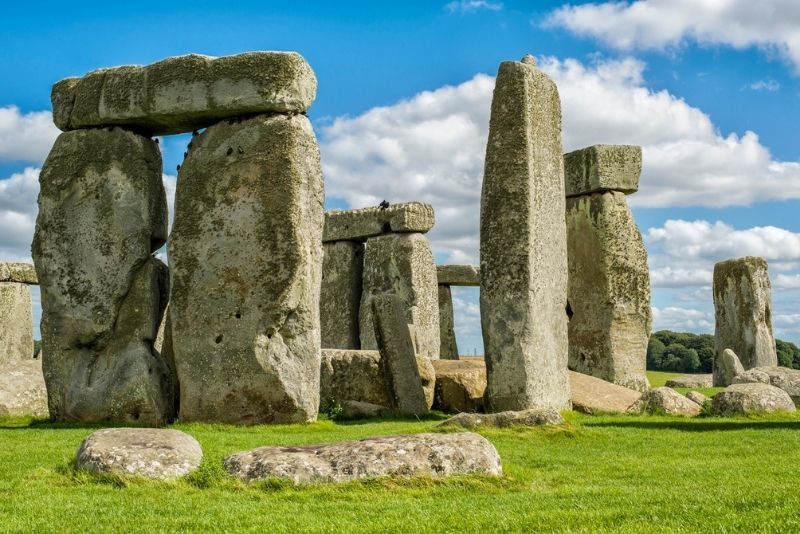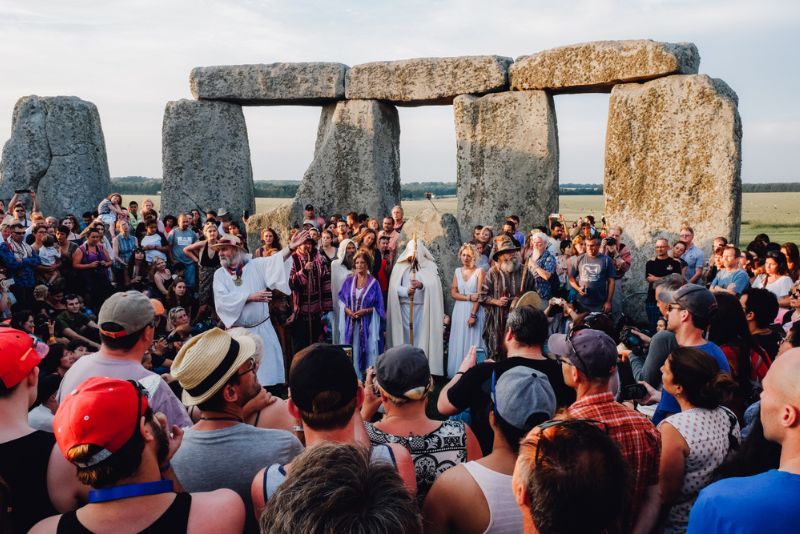Stonehenge: Day Trips and Tours from Bath
The stone circle of Stonehenge is one of the most recognizable monuments in the world, with a history that stretches back almost 5,000 years. One of England’s greatest mysteries, historians and archaeologists have not yet confirmed the reason behind the construction of this giant monument.
Travelers heading to the south of England must pay this attraction a visit on a Stonehenge day trip from Bath and delve into its fascinating history.
The stone circle of Stonehenge is one of the most recognizable monuments in the world, with a history that stretches back almost 5,000 years. One of England’s greatest mysteries, historians and archaeologists have not yet confirmed the reason behind the construction of this giant monument.
Travelers heading to the south of England must pay this attraction a visit on a Stonehenge day trip from Bath and delve into its fascinating history.

(0/24) checking Musement...
The stone circle of Stonehenge is one of the most recognizable monuments in the world, with a history that stretches back almost 5,000 years. One of England’s greatest mysteries, historians and archaeologists have not yet confirmed the reason behind the construction of this giant monument.
Travelers heading to the south of England must pay this attraction a visit on a Stonehenge day trip from Bath and delve into its fascinating history.

Up next, you can check out our comprehensive guide on Stonehenge, one of the most exciting day trips from Bath.
Where is Stonehenge and how do I get there from Bath?
Stonehenge is located on the Salisbury Plain of Wiltshire in Southern England. It is approximately 80 kilometers southeast of Bath.
From Bath to Stonehenge by car
The journey to Stonehenge takes less than an hour and begins by traveling out of Bath in a southeasterly direction. You’ll follow the A36 as far as Heytesbury where it splits. Here, you’ll take the left fork along the B390, followed by the A360 to reach your destination.
From Bath to Stonehenge by public transport
Those without access to a car can instead make the jaunt to Stonehenge via public transport. You can catch a train from Bath to Salisbury, which takes approximately 50 minutes. From there, you’ll catch the local bus Line 3, which runs hourly between 10 AM and 2 PM from outside the railway station to the prehistoric site. This takes an additional 30 minutes, making your journey time around 1.5 hours.
Guided tour to Stonehenge from Bath
Join a guided excursion to Stonehenge and let someone else take care of the transportation details for you. These day trips typically last between 4 and 9 hours, depending on whether they visit additional destinations or not, and start between 8 AM, and 9 AM.
In some instances, you’ll be provided with a public meeting spot in Bath, which you’ll reach independently on the morning of your trip, while in other cases, you’ll enjoy a convenient hotel pickup service.
How much do Stonehenge tickets cost?
Stonehenge tickets vary in price, depending on the time of year and how popular the attraction is. In general, it is cheaper on weekdays, while weekends and public holidays are more expensive.
You’ll have the option to add a donation to your pass and you’ll save 10% if you book your tickets online in advance. Concessions include students with appropriate identification and seniors aged 65, and over.
- Adults: £20.90 - £23.60
- Children aged 5 - 17: £12.70 - £14.50
- Children under 5: Free
- Concessions: £18.10 - £20.90
- Family pass (one adult plus three children:) £33.60 - £38.10
- Family pass (two adults plus three children:) £54.50 - £61.70
What is the typical itinerary?
Each Stonehenge day trip has its own unique itinerary. However, they all start with meeting your guide, either in the city center or your hotel, and then you’ll head toward the ancient site.
Some tours may begin with a guided walking tour of Bath and its historic center of Bath. Afterward, you’ll travel straight to the stone circle for a tour, either via an audio headset or with an in-person guide at your side. Typically, you will have some additional time to discover the monument.
Depending on the tour, you may then continue to more locations in the southern stretch of England, such as the nearby Avebury Stone Circle and the enchanting villages of the Cotswolds, before returning to Bath.
What are the best Stonehenge day trips from Bath?

There are several different Stonehenge day trips to choose from, depending on whether you wish to explore other destinations or not.
Day Trip to Stonehenge and Bath City Tour
Those wanting to discover England’s ancient history can combine their day trip to Stonehenge with a city tour of Bath, which was founded in the 1st century A.D. You’ll enjoy a walking tour through this Roman city where you’ll pass by a wealth of historic monuments, including the Jane Austen Center, Roman Baths and Bath Abbey. Once you’ve admired these attractions, you’ll journey to Stonehenge, to learn more about how it believed this ancient stone circle was formed.
Day trip to Stonehenge plus Avebury and the Cotswolds from Bath
For a more comprehensive excursion, consider a day tour of Stonehenge, Avebury and the Cotswolds. After strolling the grounds of Stonehenge with an audio guide, you’ll discover the UNESCO-listed Avebury Stone Circle, which was built over a period of more than 800 years during the 3rd millenium B.C.
Travel even further back in time by stopping to see Silbury Hill, which is almost 5,000 years old, before ambling through the beautifully preserved villages of the Cotswolds, famed for its wool trading.
Private tour to Stonehenge from Bath
If you’re looking for greater flexibility than a group tour allows, consider a private Stonehenge day tour. You’ll enjoy a comfortable ride through the English countryside, learning about the landmarks you pass along the way from your insightful guide.
Upon arrival at Stonehenge, you’ll wander the archaeological site together, discussing archaeological finds both old and new. You’ll then have some free time to revisit the ruins and marvel at the history behind the stone circle before returning to Bath.
How much do day trips to Stonehenge from Bath cost?
Day trips to Stonehenge plus Avebury and the Cotswolds cost between £70, and £80 per adult aged 16 and over. Children aged 5 to 15 cost £35 each, and the excursion is not suitable for children below this age. These tours operate in small groups limited to 14 participants.
Private half-day Stonehenge tours cost between £290 and £300 per solo traveler. By adding extra individuals to your party, you’ll save money and with a party of six, you’ll each pay just over £70.
Day tours of Stonehenge and Bath are also private affairs with groups limited to six participants, and cost just over £500 for solo travelers. However, the price per head reduces with each additional participant, bringing the cost to just under £110 each.
What are the highlights at Stonehenge?

The first part of Stonehenge was laid approximately 5,000 years ago, while its stone circle was formed during the 3rd millennium B.C. The site was built using sarsen standing stones, which were dug from a quarry and transported to their destination via wooden sleds, and manpower. Each of these stones measures up to 4 meters high and weighs approximately 250 tons.
In recent years, researchers have claimed that Stonehenge was built to form a large lunar calendar that links to the ancient Egyptian world. However, this theory remains unconfirmed. Other hypotheses include the site acting as a burial ground, temple of the dead or a ceremonial monument.
Together with nearby Avebury, Stonehenge forms a UNESCO World Heritage Site, and both monuments were built within approximately 100 years of each other. Stonehenge is made up of around 50 stones and archaeologists have found human remains from the Neolithic period, which stretched between 2,200 B.C., and 1,000 B.C.
What are the opening times?
Stonehenge is open 7 days a week, from 9:30 AM to 5 PM.
When is the best time to visit Stonehenge?

The best time to visit Stonehenge is from April to October, when the weather is generally mild. Keep in mind though that the monument can get very busy in the summer, especially for the solstice. Visits in the early morning or late evening are more peaceful, as it tends to get crowded after 11 am.
Are there any tours to Stonehenge from other cities in England?
Yes, there are tours departing from other cities in England:
- Day trips to Stonehenge from London
- Day trips to Stonehenge from Southampton
- Day trips to Stonehenge from Brighton
- Day trips to Stonehenge from Oxford
- Day trips to Stonehenge from Salisbury
Travel tips
- Stonehenge is particularly popular during the summer and school holidays, so book your tickets or tour in advance to avoid disappointment.
- Make sure you wear comfortable walking shoes, as there is a lot to explore around Stonehenge.
- The weather in the UK is notoriously unpredictable and it can get very windy around Stonehenge, so dress warm and bring along a light raincoat or an umbrella, just in case it rains.

